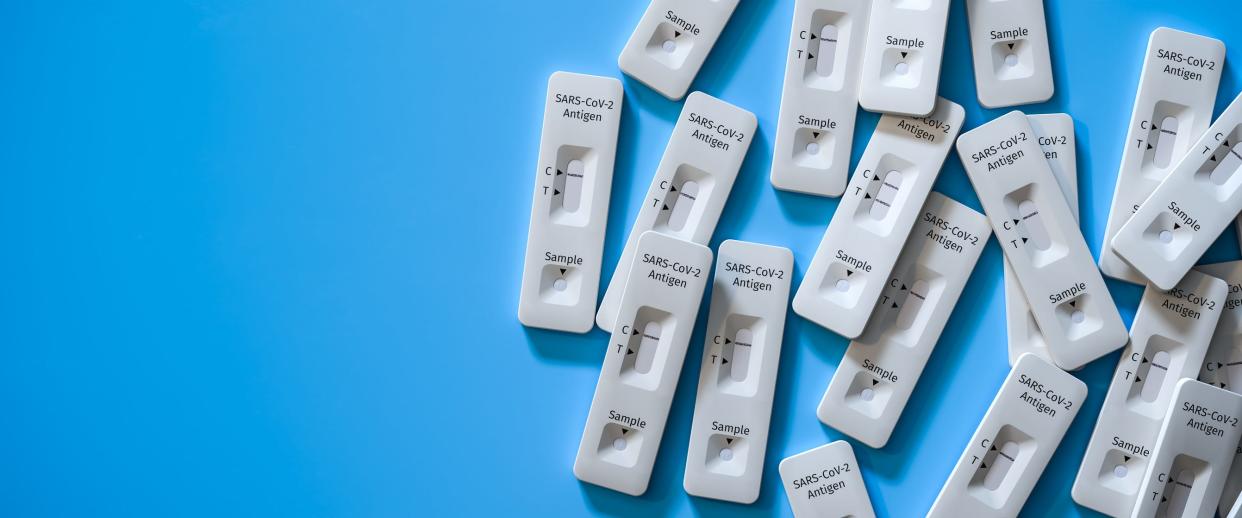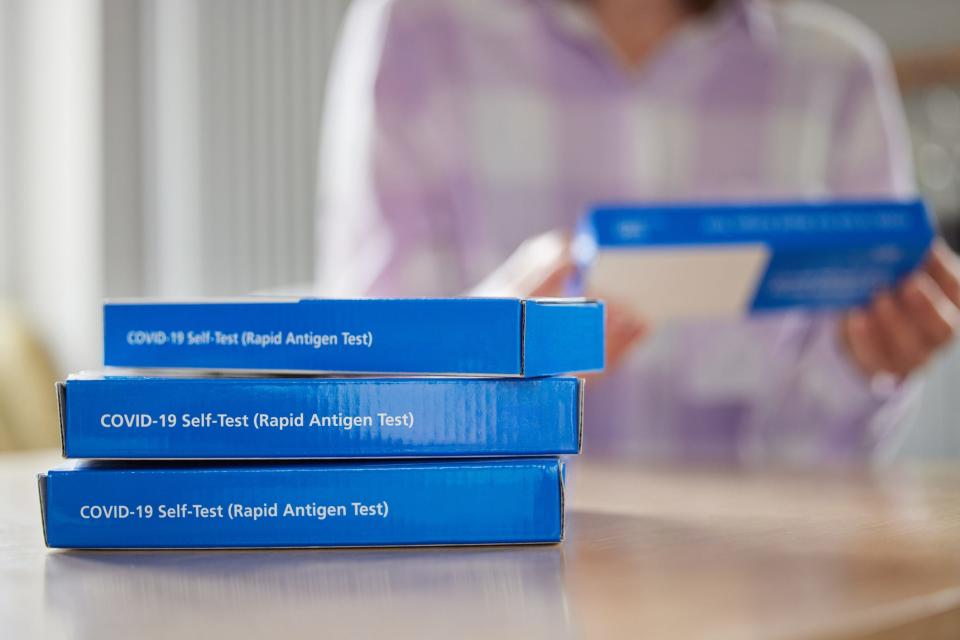More free COVID tests are available this holiday season: How to order yours

- Oops!Something went wrong.Please try again later.
The government is offering another round of free at-home COVID tests to Americans in time for the holiday season. As flu and RSV season kick into full swing, precautions meant to keep families healthy before large holiday gatherings are on the minds of many.
This time around, the round of free tests comes just as insurance companies are no longer required to pay for COVID testing, which was once covered to the tune of eight take-home tests a month. Research from independent organization KFF found that at-home tests generally cost between $12 and $24 per pack, averaging in at $11 per test.
While there are options for free testing at centers within communities across the U.S., and the Department of Health and Human Services is still distributing free at-home tests to schools, nursing homes, community health centers, rural health clinics and food banks, some people are simply looking for the ease and access at-home testing provides.
Luckily, it's easy to put your order in, and people who didn't take advantage of the free round made available back in September are eligible to submit two orders at one time in order to stock up
Keep germs to yourself this cold season: Have you caught a cold? Here's how long you will be contagious.
How to get free COVID tests from the government

Every U.S. household is eligible to order four free at-home tests beginning Monday, Nov. 20. Every home is entitled to at least four, but those who did not receive the last round made available in Sept. are able to place two orders and get up to eight.
To order online, visit COVIDtests.gov and fill out the form which asks for your full name and mailing address. The tests will then be shipped free via USPS to the provided location, including P.O. boxes. You will receive an order number and updates via email if you choose to input your email address.
Orders begin shipping the week of Nov. 27, according to the confirmation screen at the end of the order process. Consumers will also see a warning on this screen that the free tests might show expired dates on the box but advises the tests are still good as per the Food and Drug Administration extending expiration dates for home coronavirus tests.
Those unable to access the online order form or who otherwise need assistance can call 1-800-232-0233 (TTY 1-888-720-7489). The Disability Information and Access Line (DIAL) is also available to help people with disabilities place their orders at 1-888-677-1199 or DIAL@usaginganddisability.org.
For those who have questions about eligibility, the online ordering form, shipping, or delivery, you can contact the USPS Help Desk at 1-800-ASK-USPS (1-800-275-8777).
"Staggering": Measles deaths have nearly doubled globally, according to new CDC data. Here's why.
What to expect after placing your order
Once shipped, tests are sent via USPS Ground Advantage, which has an expected two-to-five-day delivery time according to the USPS website.
It's important to keep in mind that at-home tests are rapid antigen and not PCR test, which is generally considered the most accurate. According to the Centers for Disease Control and Prevention, at-home antigen tests take only minutes and are accurate and reliable when reporting positive results.
However, PCR tests are more likely to detect the virus even when the patient is exhibiting no symptoms. Because of this, the FDA recommends two negative antigen tests for individuals with symptoms or 3 antigen tests for those without symptoms, performed 48 hours apart. Only a single PCR test is required by comparison.
If you need testing more quickly, there are other programs offering free or low-cost tests, including community-based testing sites.
COVID this holiday season
As colder weather approaches, flu and RSV season are concerns alongside coronavirus. COVID-19 infections have been up and down since this summer, according to the CDC, with weekly hospitalizations hitting 20,678 on Sept. 9 and 16,239 on Nov. 11.
The many gatherings that happen around the holiday season can pose an increased risk for transmission, meaning testing is a good idea even if you don't have symptoms before attending an event, gathering, or visiting an at-risk individual.
If you're concerned about COVID around your loved ones this holiday season, the CDC suggests a few precautions, including:
Test as close to the time of the event as possible (at least within 1-2 days).
If you use an antigen test, follow recommendations for repeat testing to be confident in a negative result.
Additionally, you may want to find a free testing location or visit your doctor for a PCR test before visiting people with a higher risk for severe illness.
Consider practicing social distancing or wearing masks during large gatherings, while traveling, or during other high-transmission events where at-risk people may be.
Keep up to date on your COVID vaccines and boosters. Get your Flu and RSV shots if you're able to as well.
Get vaccines at least two weeks before holiday travel or gatherings.
Keep up with handwashing and good hygiene practices.
Stay home if you are infected or have symptoms of illness.
If you have symptoms, test immediately.
If you are only going to take a single test, a PCR test will provide a more reliable negative test result.
If you use an antigen test, a positive result is reliable, but a negative test is not always accurate.
If your antigen test is negative, take another antigen test after 48 hours or take a PCR test as soon as you can.
If you do not have symptoms but have been exposed to COVID-19, wait at least 5 full days after your exposure before taking a test.
If you are only going to take a single test, a PCR test will provide a more reliable negative test result.
If you use an antigen test, a positive result is reliable, but a negative test is not always accurate.
If your antigen test is negative, take another antigen test after 48 hours or take a PCR test as soon as you can.
If your second antigen test is also negative, wait another 48 hours and test a third time.
This article originally appeared on USA TODAY: Get free COVID tests from the government shipped from USPS

